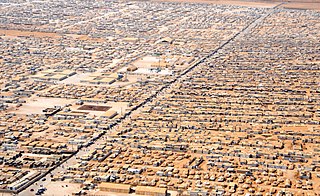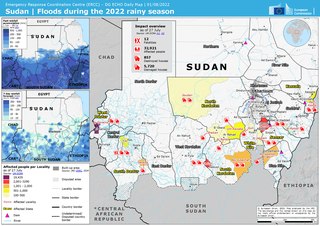The Office of the United Nations High Commissioner for Refugees (UNHCR) is a United Nations agency mandated to aid and protect refugees, forcibly displaced communities, and stateless people, and to assist in their voluntary repatriation, local integration or resettlement to a third country. It is headquartered in Geneva, Switzerland, and has 20,305 staff working in 136 countries as of December 2023.

An internally displaced person (IDP) is someone who is forced to leave their home but who remains within their country's borders. They are often referred to as refugees, although they do not fall within the legal definitions of a refugee.

A refugee camp is a temporary settlement built to receive refugees and people in refugee-like situations. Refugee camps usually accommodate displaced people who have fled their home country, but camps are also made for internally displaced people. Usually, refugees seek asylum after they have escaped war in their home countries, but some camps also house environmental and economic migrants. Camps with over a hundred thousand people are common, but as of 2012, the average-sized camp housed around 11,400. They are usually built and run by a government, the United Nations, international organizations, or non-governmental organization. Unofficial refugee camps, such as Idomeni in Greece or the Calais jungle in France, are where refugees are largely left without the support of governments or international organizations.

An emergency shelter is a place for people to live temporarily when they cannot live in their previous residence, similar to homeless shelters. The main difference is that an emergency shelter typically specializes in people fleeing a specific type of situation, such as natural or man-made disasters, domestic violence, or victims of sexual abuse. A more minor difference is that people staying in emergency shelters are more likely to stay all day, except for work, school, or errands, while homeless shelters usually expect people to stay elsewhere during the day, returning only to sleep or eat. Emergency shelters sometimes facilitate support groups, and/or provide meals.

Shigeru Ban is a Japanese architect, known for his innovative work with paper, particularly recycled cardboard tubes used to quickly and efficiently house disaster victims. Many of his notable designs are structures which are temporary, prefabricated, or incorporate inexpensive and unconventional materials in innovative ways. He was profiled by Time magazine in their projection of 21st-century innovators in the field of architecture and design.
Frederick C. Cuny was an American humanitarian whose work spanned disaster relief and recovery from war and civil conflict. He was a practitioner, author, and a researcher.

Medair is an international non-governmental organisation (INGO) whose purpose is to relieve human suffering in some of the world's most remote and devastated places. Medair aims to assist people affected by natural disasters and conflict to recover with dignity through the delivery of quality humanitarian aid.

Transitional shelter is any of a range of shelter options that help people affected by conflict or natural disasters who have lost or abandoned their housing until they can return to or recover acceptable permanent accommodation. The term refers to an incremental process rather than a product, in which a shelter can be:
- upgraded into part of a permanent house;
- reused for another purpose;
- relocated from a temporary site to a permanent location;
- resold, to generate income to aid with recovery; and
- recycled for reconstruction.

An earthquake occurred at on 8 October 2005 in Azad Jammu and Kashmir, a territory under Pakistan. Its epicenter was 19 km northeast of the city of Muzaffarabad, and 90 km north north-east of Islamabad, the capital city of Pakistan, and also affected nearby Balakot in Khyber Pakhtunkhwa and some areas of Jammu and Kashmir, India. It registered a moment magnitude of 7.6 on the Richter scale and had a maximum Mercalli intensity of XI (Extreme). The earthquake was also felt in Afghanistan, Tajikistan, India and the Xinjiang region. The severity of the damage caused by the earthquake is attributed to severe upthrust. Although not the largest earthquake to hit this region in terms of magnitude it is considered the deadliest, surpassing the 1935 Quetta earthquake. Sources indicate that the official death toll in this quake in Pakistan was between 73,276 and 87,350, with some estimates being as high as over 100,000 dead. In India, 1,360 people were killed, while 6,266 people were injured. Three and a half million people were left without shelter, and approximately 138,000 people were injured in the quake.

Superadobe is a form of earthbag construction that was developed by Iranian architect Nader Khalili. The technique uses layered long fabric tubes or bags filled with adobe to form a compression structure. The resulting beehive-shaped structures employ corbelled arches, corbelled domes, and vaults to create sturdy single and double-curved shells. It has received growing interest for the past two decades in the natural building and sustainability movements.

The Emergency Architects Foundation is a French non-governmental organization, reconnue d'utilité publique. It is organised as a not-for-profit foundation with the French Order of Architects as supporters and is accredited by the United Nations and the European Union. The Emergency Architects Foundation is also present in Australia and in Canada . The aim of Emergency Architects is to bring help and technical aid to the victims of natural, technological and human disasters, not only in safety and security evaluations of the populations but also in post-disaster reconstruction programs focused on long-term development and risk mitigation.
MERCY Malaysia or Malaysian Medical Relief Society is a non-profit organisation focusing on providing medical relief, sustainable health related development and risk reduction activities for vulnerable communities in both crisis and non-crisis situations. As a non-profit organisation, MERCY Malaysia relies solely on funding and donations from organisations and generous individuals to continue their services to provide humanitarian assistance to beneficiaries, both in Malaysia and internationally. The organisation is a registered society according to the Societies Act 1966 in Malaysia, and the headquarters is in the capital city of Kuala Lumpur.
IsraAID is an Israel-based non-governmental organization that responds to emergencies all over the world with targeted humanitarian help. IsraAID was founded by Shachar Zahavi and Mully Dor. This includes disaster relief, from search and rescue to rebuilding communities and schools, to providing aid packages, medical assistance, and post-psychotrauma care. IsraAID has also been involved in emergency response and international development projects in more than 60 countries, with focuses on Water, Sanitation & Hygiene, public health and medical care education, and mental health and protection.
Africa Humanitarian Action (AHA) is a non-governmental organization that provides relief services to countries in Africa. It was founded by Dr. David Zawde in 1994 in response to the Rwandan genocide.
Qatar Charity is a humanitarian and development non-governmental organization in the Middle East. It was founded in 1992 in response to the thousands of children who were made orphans by the Afghanistan war and while orphans still remain a priority cause in the organization's work with more than 150,000 sponsored orphans, it has now expanded its fields of action to include six humanitarian fields and seven development fields.

Syrian refugee camp and shelters are temporary settlements built to receive internally displaced people and refugees of the Syrian Civil War. Of the estimated 7 million persons displaced within Syria, only a small minority live in camps or collective shelters. Similarly, of the 8 million refugees, only about 10 percent live in refugee camps, with the vast majority living in both urban and rural areas of neighboring countries. Beside Syrians, they include Iraqis, Palestinians, Kurds, Yazidis, individuals from Somalia, and a minority of those who fled the Yemeni and Sudanese civil wars.
Al-Khair Foundation (AKF) is an international Muslim aid NGO based in the United Kingdom and Turkey, and is the third largest Muslim charity in the UK. It was established in 2003, and aims to deliver aid to the poor and vulnerable, as well as education for the Muslim community. It specialises in humanitarian support, international development, emergency aid and disaster relief in some of the world's most deprived areas.
United Nations General Assembly Resolution 48/144 of 20 December 1993 is a resolution in which the General Assembly expressed its concern at the ongoing degradation of the humanitarian situation in Azerbaijan because of the displacement of considerable number of citizens due to Nagorno Karabakh conflict and supporting "emergency international assistance to refugees and displaced persons in Azerbaijan". The resolution is titled “48/114. Emergency international assistance to refugees and displaced persons in Azerbaijan”. It became the fifth United Nations document concerning Nagorno-Karabakh and the first United Nations General Assembly document on humanitarian aid to those affected by this conflict. This resolution was the first international document affirming the number of refugees and displaced persons in Azerbaijan exceeded one million. The document does not make any specific reference to previous UN resolutions on the ongoing conflict, but "its relevant resolutions regarding humanitarian assistance to refugees and displaced persons". The resolution was adopted by consensus without voting.
Internally displaced persons in Syria are more than half the people fleeing the Syrian Civil War moved only within Syria itself. The United Nations High Commissioner for Refugees (UNHCR) estimates that 7 million persons in Syria are internally displaced or in need of humanitarian assistance, as of 2017. Most live in houses, often badly damaged by the war. Due to security concerns, poor access to areas of need and unpredictability, humanitarian efforts were directed at emergency aid. The complexity of administrative procedures and limited capacity of NGOs permitted to operate in Syria are also cited as challenges to assistance.

The 2022 Sudan floods saw the figure for flood-affected people in Sudan had exceeded the figure for 2021, rising to 314,500. From 2017 to 2021, there were 388,600 people affected by floods annually.















